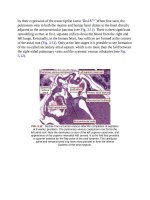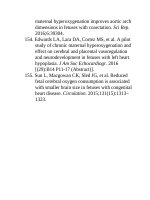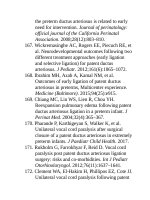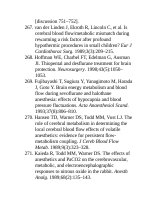Andersons pediatric cardiology 964
Bạn đang xem bản rút gọn của tài liệu. Xem và tải ngay bản đầy đủ của tài liệu tại đây (123 KB, 3 trang )
althoughoccasionallytheorientationisbetterwithanastomosistotheunderside
ofthearch.
FIG.36.20 Surgicaltechniqueforcreationofanend-to-side
aortopulmonaryconnection(aortopulmonarywindow,Melbourneshunt).
(A)Themainpulmonaryarteryisdividedasproximallyaspossibleand
spatulatedwithalongitudinalincision.(B)Apartial-occludingaorticclamp
isappliedtotheaorta,usuallytothepostero-leftwardaspect.(C)The
aortotomyisperformedandtheanastomoticsiteisenlargedbyexcisinga
buttonofaortictissue,andtheanastomosisisperformedwithcontinuous
7-0monofilamentabsorbablesuture.Theoptimallocationforanastomosis
variesaccordingtoanatomicvariables,includingbothpulmonaryartery
anatomyandaorticsizeandposition.(D)Inmostcases,aleft
posterolateralanastomosisjustabovethesinotubularjunctionis
performed,butifthelieofthepulmonaryarteryisbetter,theanastomosis
istotheundersideoftheaorticarch(E).(FromRodefeldMD,ReddyVM,
ThompsonLD,etal.Surgicalcreationofaortopulmonarywindowin
selectedpatientswithpulmonaryatresiawithpoorlydeveloped
aortopulmonarycollateralsandhypoplasticpulmonaryarteries.JThorac
CardiovascSurg.2002;123:1147–1154.)
AnestheticConsiderations
Thereareanumberofimportantanestheticconsiderationsinpatientswith
TOF/PA/MAPCAsundergoingunifocalization.Asidefrompatientswithextreme
cyanosisorcongestiveheartfailure,inhaledinductionwithsevofluraneis
appropriateinmostcircumstances.Thefractionofinspiredoxygenusedduring
inductionandmaintenanceshouldvaryaccordingtothedegreeofpreoperative
pulmonarybloodflow,typicallytomaintainanoxygensaturationof75%to
85%.Theanesthesiologistshouldbepreparedforadifficultintubation,
particularlyinpatientswithachromosome22q11deletion,whomayhave
airwayanomalies55,57;however,maskventilationcanusuallybeperformed
withoutcompromise.61
Priortoinitiatingcardiopulmonarybypass,itisimportanttomaintain
adequatesystemicperfusionpressuretoavoidsystemicacidosis,hypoxemiain
patientswithtortuousandstenoticMAPCAs,andcoronaryhypoperfusionin
patientswithhighpulmonarybloodflow(i.e.,duetoextensiverunoffthrough
MAPCAs).Forthisreason,volatileagents—whichdecreasebloodpressure,
systemicvascularresistance,andcardiacoutput—typicallyarenotusedafter
induction,andatotalintravenousanesthetictechniqueisemployed.Insome
instances,hypoxemiaduetoligationofMAPCAs,alongwithongoingblood
loss,canresultinsignificantmetabolicacidosis.Administrationofbicarbonate
andmaintenanceofanadequatehematocritforoxygen-carryingcapacityare
importantinsuchcases.Theuseofalow-doseinotrope,suchasdopamine3to5
µg/kgperminute,improvescardiacoutputandsupportsarterialbloodpressure
duringthedissectionandligationperiod.
Inseparatingfromcardiopulmonarybypass,wetypicallyusedopamineat5
µg/kgperminute,milrinoneat0.5µg/kgperminute,andlow-doseepinephrine
forinotropicsupport.Morerecentlytheempiricuseofinhalednitricoxidehas
beeninstitutedtodecreasethepressureimposedonthenewlyanastomosed
pulmonaryvessels.Bloodlossmaybesignificantduetoprolongeddissection,
ligationofnumerousMAPCAs,extensivesuturelines,singleorbilateral
pulmonaryarterialaugmentation,placementofarightventricle–to-pulmonary
arteryconduit,andclosureofaventricularseptaldefect.Historicallytheroutine
useofantifibrinolytics,suchasaminocaproicacid,wasavoidedinthesepatients
duetoconcernsaboutthrombosisinthenewlyanastomosedvessels.However,
ourcurrentperspectiveisthatthrombosisisoflessconcernrelativetotheriskof
significantbleedingwithredosternotomy.62Standardbloodmanagementatour
institutiongenerallyincludes0.5to1unitofpackedredbloodcellspriorto
cardiopulmonarybypass;2to4unitsofpackedcellsand2to3unitsoffresh
frozenplasmaonbypass;and1to2unitsofpackedcells,2to4unitsof
cryoprecipitate,and1to3unitsofplateletsafterbypass.Wetypicallygiveat
leastthefirstplateletunitasaplasma-reducedunittomaximizethenumberof
functionalplateletsgiveninthesmallestvolume.Thepromptadministrationof
protamineinconjunctionwithcryoprecipitateandplateletsisimperativeto
achieverapidhemostasis.WehaverecentlyusedFEIBA(BaxaltaUS),afourfactorprothrombincomplexconcentrate,atadoseof10U/kg,whichhasproven
tobebeneficialinreducingbloodproductadministrationandinachieving
prompthemostasis,thuslimitingtheuseofbloodproducts.
PostoperativeManagement
Thepostoperativecardiacphysiologyafterunifocalizationsurgerydependsin
partonwhethercompleterepair(withclosureofventricularseptaldefect)was
performed.Childrenundergoingsingle-stageunifocalizationandrepairhave
normaloxygensaturationswithoutintracardiacmixingpostoperatively.They
returntothecardiacintensivecareunitwithleftatrialandrightventricular
intracardiaclinesforclosehemodynamicmonitoring.Although
cardiopulmonarybypasstimescanbeprolongedinchildrenundergoing
extensivepulmonaryarteryreconstruction,theaorticcross-clamptimesare
usuallyrelativelyshortandthelowcardiacoutputexpectedaftersurgeryis
mild.63Withourapproach,nearlyallpatientshavesystolicpulmonaryartery
pressureslessthanhalfsystemicafterrepair,andmosthavepressuresequaltoor
lessthan40mmHg.42Thishasimportantimplicationsforthepostoperative
course,asrightventricularpressuresremainlowandrightventricular
dysfunctionisrare.
Respiratoryfailureinthepostoperativeperiodismultifactorial.Toachievethe
lowestpulmonaryarterypressurepossible,surgicaldissectionintothesegmental
levelofthelungsisoftennecessarytoenlargetheperipheralpulmonary









